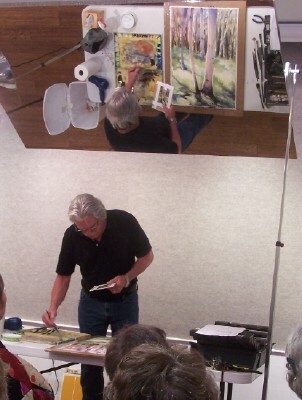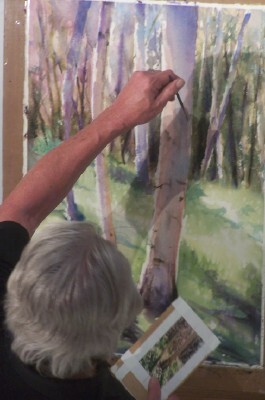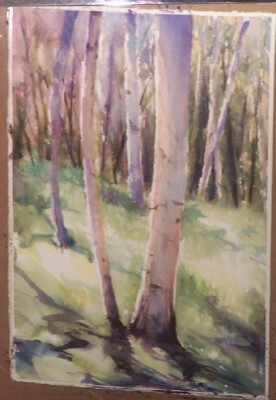JUNE MEETING - Part 3

In his folksy way, Tom shared with us his “7 Pearls of Painting” which are:
1. Drawing. This is fundamental, and needs to be relatively accurate but not precise.
2. Squinting. As mentioned before, a camera compresses the values, but Tom believes that squinting helps us define the values better since the darks get a little lighter and the lights a little darker when we squint.
3. Design (composition). Tom uses the “tic tac toe” grid pattern and uses the “sweet spots” for his focal points. There are usually 3 focal points – primary (the “star” of the painting), secondary (the “co-star”) and tertiary (the supporting cast).
4. Value.
5. Color. Tom rarely uses his paints straight from the tube, but likes to calm or settle down his colors, using raw color sparingly. He asserts that in nature there are very few colors that are not toned down by another color.
6. Edges. Tom asserted the need for both soft (or lost) edges and hard (or found) edges, referencing paintings from the masters showing how mixing edges can incorporate the main subject into the background without that “pasted on” look.
7. Paint manipulation. This references the various ways we lay down the paint – for instance, by glazing, building up or scratching out.
Tom also reminded us of the “power of 7” that surrounds us such as the 7 days of the week, the 7 sacraments and 7 deadly sins, to name but a few “seven” references.

A few of Tom’s other “pearls of wisdom” are:
• He avoids “cutesy” tricks, but will use salt sparingly.
• A unified palette is important; in other words, carry color throughout the painting for unity in the painting. Tom currently is using the colors used by Sargeant.
• Paint like “who cares”; in other words, paint with abandon and joy.
• Paint with kindergarten values; in other words, paint with your fingers if you want and ignore the rules.
• Don’t use a pure white palette or you will get too much contrast between your color and the palette; he prefers a palette that shows some color (such as an older watercolor palette that has had some use) or, when painting in acrylic or oil, a palette covered in grayish tones of prior dried colors.
• To highlight areas in the painting, use complementary colors.
• “Molest” the edges. While this sounds a bit frightening (!) Tom explained that “molest” means to change or alter, and he showed this concept at the end of his painting as he used water or more paint application scumbled here and there to soften some of his edges.
• He also believes in “doing what it takes” and sometimes he uses white watercolor paint in his watercolor paintings. (He asked how many of us were “purists” in watercolor just before – OH HORRORS – spattering that white paint over his painting!)

During his painting demo, Tom used one large flat brush almost exclusively, with a rigger and small round brush used for some of the branches and vegetation surrounding the tree trunks.

